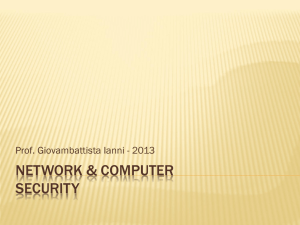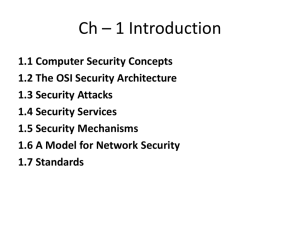William Stallings, Cryptography and Network Security 6/e
advertisement
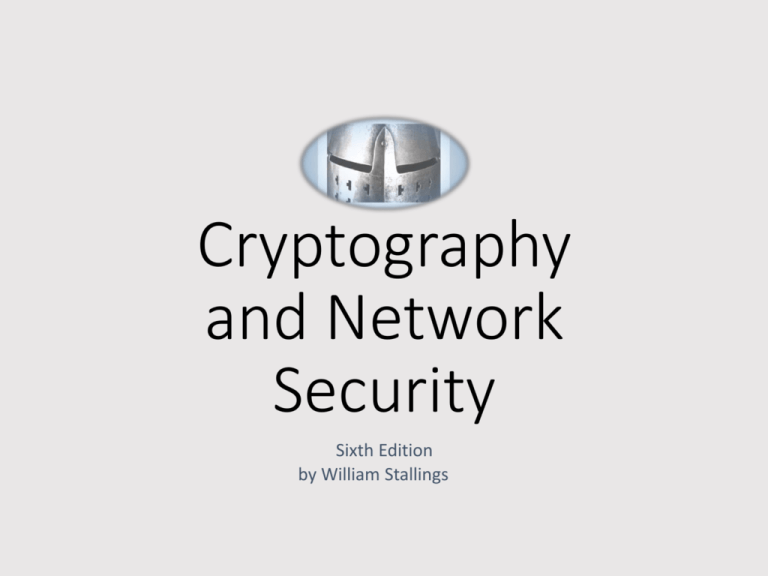
Cryptography and Network Security Sixth Edition by William Stallings Chapter 1 Overview “The combination of space, time, and strength that must be considered as the basic elements of this theory of defense makes this a fairly complicated matter. Consequently, it is not easy to find a fixed point of departure.” — On War, Carl Von Clausewitz Cryptographic algorithms and protocols can be grouped into four main areas: Symmetric encryption • Used to conceal the contents of blocks or streams of data of any size, including messages, files, encryption keys, and passwords Asymmetric encryption • Used to conceal small blocks of data, such as encryption keys and hash function values, which are used in digital signatures Data integrity algorithms • Used to protect blocks of data, such as messages, from alteration Authentication protocols • Schemes based on the use of cryptographic algorithms designed to authenticate the identity of entities The field of network and Internet security consists of: measures to deter, prevent, detect, and correct security violations that involve the transmission of information Computer Security • The NIST Computer Security Handbook defines the computer security as: term “the protection afforded to an automated information system in order to attain the applicable objectives of preserving the integrity, availability and confidentiality of information system resources” (includes hardware, software, firmware, information/data, and telecommunications)” Computer Security Objectives Confidentiality • Data confidentiality • Assures that private or confidential information is not made available or disclosed to unauthorized individuals • Privacy • Assures that individuals control or influence what information related to them may be collected and stored and by whom and to whom that information may be disclosed Integrity • Data integrity • Assures that information and programs are changed only in a specified and authorized manner • System integrity • Assures that a system performs its intended function in an unimpaired manner, free from deliberate or inadvertent unauthorized manipulation of the system Availability • Assures that systems work promptly and service is not denied to authorized users CIA Triad Possible additional concepts: Authenticity Accountability • Verifying that users are who they say they are and that each input arriving at the system came from a trusted source • The security goal that generates the requirement for actions of an entity to be traced uniquely to that entity Breach of Security Levels of Impact High • The loss could be expected to have a severe or catastrophic adverse effect on organizational operations, organizational assets, or individuals Moderate Low • The loss could be expected to have a serious adverse effect on organizational operations, organizational assets, or individuals • The loss could be expected to have a limited adverse effect on organizational operations, organizational assets, or individuals Computer Security Challenges • Security is not simple • Potential attacks on the security features need to be considered • Procedures used to provide particular services are often counter-intuitive • It is necessary to decide where to use the various security mechanisms • Requires constant monitoring • Is too often an afterthought • Security mechanisms typically involve more than a particular algorithm or protocol • Security is essentially a battle of wits between a perpetrator and the designer • Little benefit from security investment is perceived until a security failure occurs • Strong security is often viewed as an impediment to efficient and user-friendly operation OSI Security Architecture • Security attack • Any action that compromises the security of information owned by an organization • Security mechanism • A process (or a device incorporating such a process) that is designed to detect, prevent, or recover from a security attack • Security service • A processing or communication service that enhances the security of the data processing systems and the information transfers of an organization • Intended to counter security attacks, and they make use of one or more security mechanisms to provide the service Table 1.1 Threats and Attacks (RFC 4949) Security Attacks •A means of classifying security attacks, used both in X.800 and RFC 4949, is in terms of passive attacks and active attacks •A passive attack attempts to learn or make use of information from the system but does not affect system resources •An active attack attempts to alter system resources or affect their operation Passive Attacks • Are in the nature of eavesdropping on, or monitoring of, transmissions • Goal of the opponent is to obtain information that is being transmitted • Two types of passive attacks are: • The release of message contents • Traffic analysis Active Attacks • Involve some modification of the data stream or the creation of a false stream Masquerade • Takes place when one entity pretends to be a different entity • Usually includes one of the other forms of active attack Replay • Involves the passive capture of a data unit and its subsequent retransmission to produce an unauthorized effect Modification of messages • Some portion of a legitimate message is altered, or messages are delayed or reordered to produce an unauthorized effect Denial of service • Prevents or inhibits the normal use or management of communications facilities • Difficult to prevent because of the wide variety of potential physical, software, and network vulnerabilities • Goal is to detect attacks and to recover from any disruption or delays caused by them Authentication • Concerned with assuring that a communication is authentic • In the case of a single message, assures the recipient that the message is from the source that it claims to be from • In the case of ongoing interaction, assures the two entities are authentic and that the connection is not interfered with in such a way that a third party can masquerade as one of the two legitimate parties Access Control • The ability to limit and control the access to host systems and applications via communications links • To achieve this, each entity trying to gain access must first be indentified, or authenticated, so that access rights can be tailored to the individual Data Confidentiality • The protection of transmitted data from passive attacks • Broadest service protects all user data transmitted between two users over a period of time • Narrower forms of service includes the protection of a single message or even specific fields within a message • The protection of traffic flow from analysis • This requires that an attacker not be able to observe the source and destination, frequency, length, or other characteristics of the traffic on a communications facility Data Integrity Can apply to a stream of messages, a single message, or selected fields within a message Connection-oriented integrity service, one that deals with a stream of messages, assures that messages are received as sent with no duplication, insertion, modification, reordering, or replays A connectionless integrity service, one that deals with individual messages without regard to any larger context, generally provides protection against message modification only Nonrepudiation • Prevents either sender or receiver from denying a transmitted message • When a message is sent, the receiver can prove that the alleged sender in fact sent the message • When a message is received, the sender can prove that the alleged receiver in fact received the message Table 1.2 Security Services (X.800) Security Mechanisms (X.800) Specific Security Mechanisms • • • • • • • • Encipherment Digital signatures Access controls Data integrity Authentication exchange Traffic padding Routing control Notarization Pervasive Security Mechanisms • • • • • Trusted functionality Security labels Event detection Security audit trails Security recovery Table 1.3 Security Mechanisms (X.800) Model for Network Security Network Access Security Model Unwanted Access • Placement in a computer system of logic that exploits vulnerabilities in the system and that can affect application programs as well as utility programs such as editors and compilers • Programs can present two kinds of threats: • Information access threats • Intercept or modify data on behalf of users who should not have access to that data • Service threats • Exploit service flaws in computers to inhibit use by legitimate users Summary • Computer security concepts • Definition • Examples • Challenges • The OSI security architecture • Security attacks • Passive attacks • Active attacks • Security services • • • • • • Authentication Access control Data confidentiality Data integrity Nonrepudiation Availability service • Security mechanisms
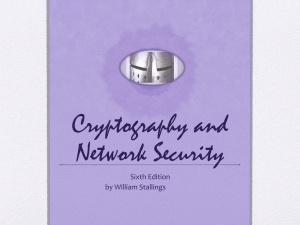
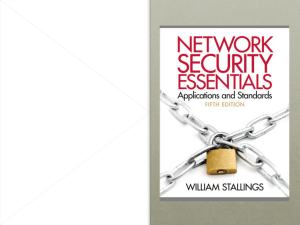
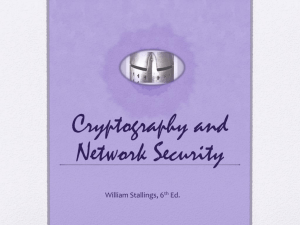
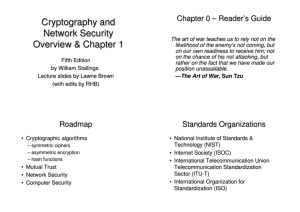
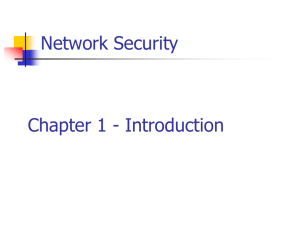

![Systems Assurance [Opens in New Window]](http://s3.studylib.net/store/data/007522633_2-e364c8f93e26286779d02c826b323ed6-300x300.png)


